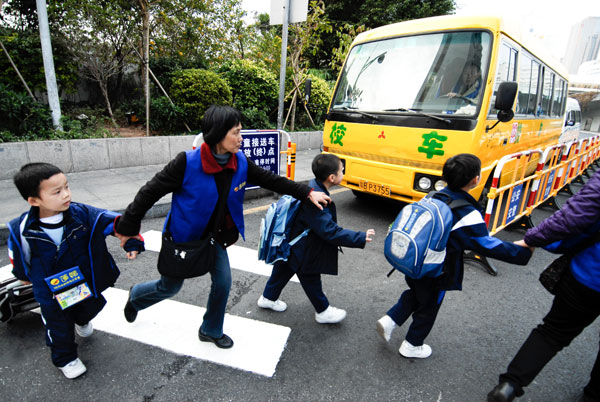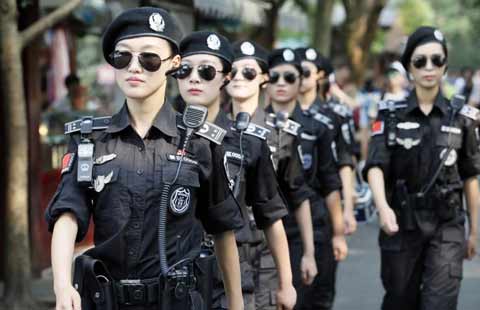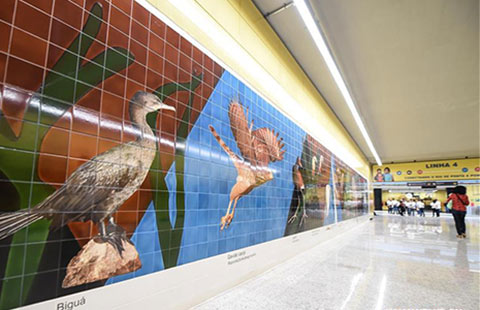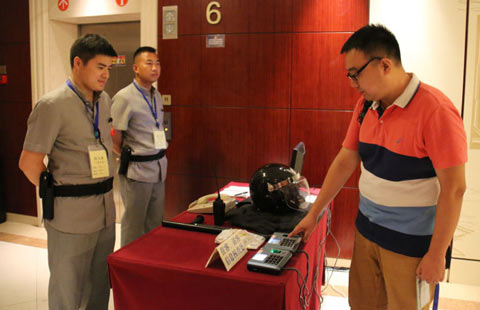School bus makers split on safety draft
By Xu Wei (China Daily) Updated: 2012-01-11 07:53BEIJING - Opinions were divided among school bus manufacturers at a national conference over proposed standards for the buses, with some complaining that a newly released draft of standards sets the bar too high.
 |
|
Pupils of a primary school prepare to take a school bus in Shenzhen, Guangdong province, on Jan 4. Provided to China Daily |
The conference, held by the Ministry of Industry and Information Technology, is aimed at seeking feedback from major bus producers on the draft of safety standards for school buses, including technical specifications and car seat standards. The solicitation of public opinion ended on Sunday.
School bus safety has been a high priority for the central government following a string of deadly road accidents involving pupils and preschoolers in the last two months of 2011. China has seen a groundswell of voices calling for safer school buses and more school bus access nationwide.
Solicitation of public opinion about the draft of the standards, made by the national technical committee of auto standardization, started at the end of December. Some automakers have voiced clear disagreements over the draft version of the new standard.
"It is way too high for most school bus manufacturers," said Tian Xiaoguang, director of a marketing research center under Baoding Chang'an Bus Manufacturing Co, a subsidiary of the Chongqing-based Chang'an Automobile Group.
Tian pointed to the specification in the draft that requires the shape of school buses to mimic the shape of US school buses, which feature a "big-nose" design where the chassis extends out from the front of the vehicle over the wheels.
He said this is "beyond China's actual conditions and the actual conditions of most school bus producers in China".
Tian said the safety of school buses is not necessarily related to its shape. He added that only a few automakers in China can currently meet the specifications for school buses as written.
Zhengzhou Yutong Bus Co, the largest professional bus maker in China by sales volume and a leading initiator of the safety specifications, said that safety cannot be sacrificed when selling school buses.
"We must raise the safety standard as high as we possibly can, or there might be greater investments in the future," said Zhang Qiang, general manager of the school bus department of Yutong.
"The more seriously we take the safety standards, the further we can spur the development of the school bus industry."
Zhang added the same research that will improve the safety of school buses can be applied to increasing the comfort of tour buses.
He also disagreed with the assertion that higher safety standards will result in a 20 percent to 30 percent increase in the cost of school buses, adding that the price of school buses produced under the new standard will only be 10,000 yuan ($1,580) more than other buses of a similar type.
Responding to Zhang, Tian said Yutong has had a production line of school buses that meet the safety standards for years, and thus can control their costs. "Most other automakers have not (set up a production line). So the construction of new production lines according to the school bus safety standard will definitely result in a sharp increase in the cost of school buses," Tian said.
Lin Chongfu, a marketing official at Huanghai Bus Group in Dandong, Liaoning province, believes the establishment of a national school bus safety standard should cater more to the needs of different users nationwide. "Schools in the rural areas and in the cities will definitely have different requirements for the school buses," Lin said. "Also, there are different requirements for schools in the mountainous areas."
Lin said a universal standard should also take into consideration the needs of the users.
Meanwhile, some experts dismiss the necessity of an excessively high safety standard for school buses.
"Why must all school buses be in the shape of big-nosed buses?" said Zhou Hongyu, a National People's Congress deputy who proposed a draft on school buses regulations in last year's annual congress session. "Even in the United States and Europe, there are school buses that are not big-nosed."Zhou believes the new safety standard must strike a balance between safety and the capacity of governments and schools.
The key solution to the school bus safety problem, Zhou says, lies in giving priority to school buses on the roads.
"The crucial part is to popularize the notion that children are a vulnerable group in our society and deserve all the accompanying privileges, not only on the roads," Zhou said.
Chu Zhaohui, a senior researcher with the China National Institute for Educational Research, also believes the establishment of a school bus system nationwide is far more important than pure improvements to the safety indexes of school buses.
"Safety indexes cannot guarantee everything," Chu said. "The school bus system in the United States and other European countries was established after a long period of trial and error."
Chu believes it will take at least three to five years to get the appropriate data for further improvement on the technical specifications of school buses.
Liu Ce in Liaoning contributed to this story.
- Samsung Electronics unveils new curved-screen Galaxy Note phone in H2 sales push
- Draft of B20 Policy Recommendation Report completed: Host committee
- Glimpse into the work and life of G20 guards
- Rio's key Olympic transport metro line uses China-made trains
- Volkswagen sales halted amid forgery allegations
- Embassy camps win Chinese over
- Airborne kids broaden ken during vacation
- Are going-out companies paying too much?


















